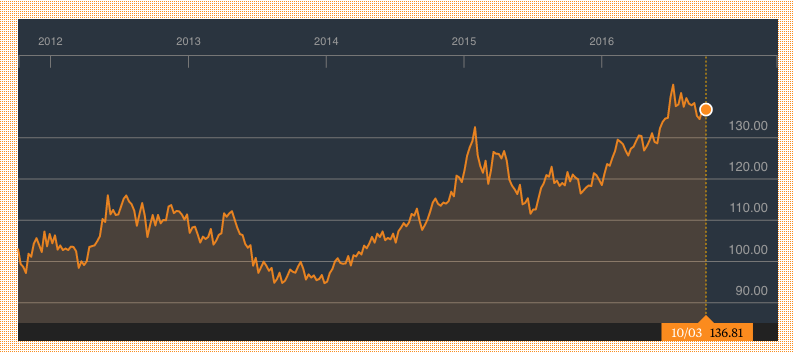Global markets ended 2013 very much the same way they unfolded, with Japan, the U.S, and other mature markets providing investors with stellar returns. On the opposite side of the spectrum, emerging markets like the BRIC countries and Turkey retreated, while in some cases, like Chile, they fell fairly quickly.
The diagnosis is quite simple as the stability and improved growth prospects in the more mature countries are now seen as a far more stable alternative to countries dependant on foreign capital and commodity booms. Investment capital flows to places where it is treated well, meaning higher returns and stable political environments as one is a byproduct of the other. Mature countries where the rule of law can be counted on and investors do not have to worry about capital confiscation (industry or company nationalization) are seen as a superior alternative until proven otherwise.
The best example of this would be what is now taking place Chile and Mexico. After nearly 35 years of a very prosperous economic environment with low taxes and privatized industrial policies, the voters in Chile have elected a leader who believes in adopting more centralized government economic policies. Capital has fled the country since the new regime was elected in November. In Mexico, a move towards increasing privatization in the telecom and energy sectors is making plenty of investors think a lot more closely about Mexico for capital placement.
Sector analysis
We all know that 2013 was a year where good returns were very common, but investing is always a practice built on what will happen in the future, so let’s look at areas which provide possibilities for 2014? My focus is on cheap sectors, so areas which did not have good years in 2013 are key places to concentrate on. Basic resources lost 1.48%, with gold miners losing a whopping 52.12% (ouch, that hurts). Coal also had trouble, retreating 14.97% for the year. Joining the misery loves company group are real estate concerns, with mortgage REIT’s losing 20.98%, and residential REIT’s down 8.34%.
Industries which also underperformed the major indexes include long time good performers soft drinks (+17.45%), tobacco (11.36%), and home construction (+9.15%). Two other notable substandard segments include fixed line telecom (+6.55%), and electric utilities (+7.15%). I would expect natural resources, real estate, and soft drinks to get very hard looks from investors trying to find bargains in the investment bin.
2014 Outlook
In December of 2013, the Dow Jones Industrial Average gained 3.0%, the S&P 500 rose by 2.35%, while the NASDAQ increased 2.87%. For the entire year, all the major averages rewarded investors anywhere from 26.5% to 35.10%. Certainly, nearly anyone who owned stocks in 2013 enjoyed an exceptional year. A more interesting question is could 2014 enjoy a similar kind of result or could the same thing happen but with negative returns? Most analysts believe 2013 will be a hard year to duplicate. The U.S. economy has grown on average about 2-2.5 percent per year over the last five years, with the third quarter of 2013 registering a quarterly growth rate of 4.1%, the best showing in quite some time. As the fourth quarter of the fiscal year is typically where activity increases, it is not unrealistic to see 2013 full year GDP growth come in at nearly 3% or even above it. Is it not possible, even probable, to think the economy builds on the existing momentum to pick up pace in 2014?
The same factors which have helped produced better economic results continue to remain in place and should do so for the foreseeable future. Energy production of oil and gas has seen a 10-15% increase in each of the last two years, and with horizontal fracking and deep water offshore drilling showing no signs of slowing down, the U.S. could very well be a major energy exporter in relatively short order. Housing should also continue to help contribute to better growth, as starts are hovering at around 1,000,000 per year where the historical average is typically around 1.5 million per year. With energy and housing being major segments in the economy, these two industries may form a solid platform from which the rest of the economy can build on.
With respect to innovation, the U.S. has to be considered a global leader in a number of crucial areas like biotechnology, pharmaceutical and drug development, genetics and genomic research, cloud, wireless, and connected computing, robotics, and the previously mentioned fracking field, just to name a few. Cheap financing for corporate borrowing, venture capital, merger and acquisition activity, and small business growth is certainly still at an attractive rate (3% on the 10 year Treasury bond). So these conditions provide fertile ground for corporations who have never been more profitable, and continue to strengthen their already impressive financial condition.
U.S. companies have used the low borrowing rates to buy back records amount of stock and shrinking the available amount of shares for potential buyers. The total volume of share buybacks certainly has helped contribute to the market’s strong performance over the last year. Some investors believe the market is too expensive and find it similar to the internet bubble in 1999 and the housing bubble of 2007 and 2008. Circumstances are different but to think that what one pays for an asset does not matter is not correct either. At this point, buyers have to be very discerning about what they buy and the price they pay, but for anyone with investing experience, is that not always the case?
DISCLAIMER: The reader should not assume that any investments identified were or will be profitable or that any investment recommendations or investment decisions we make in the future will be profitable. Investors cannot invest directly in an index. Indexes have no fees. Past performance is no guarantee of future results.




